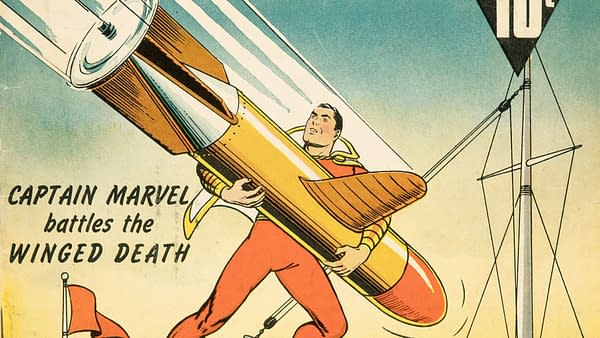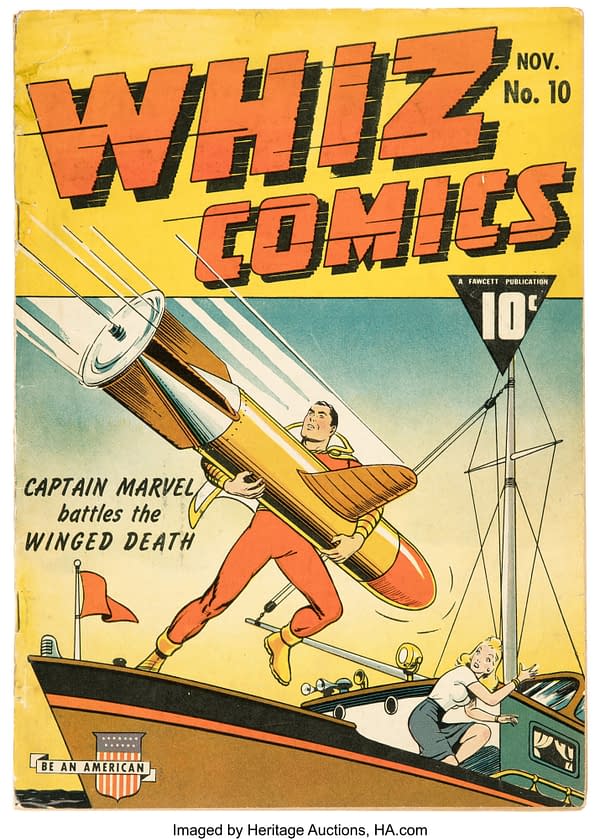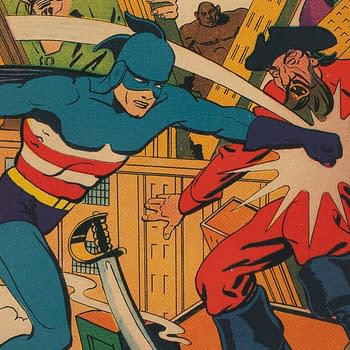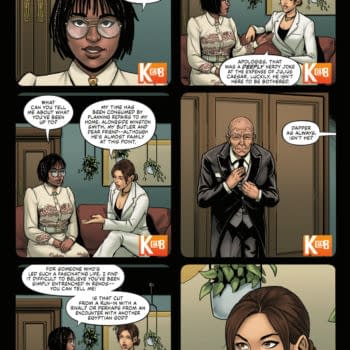Posted in: Comics, Heritage Sponsored, Vintage Paper | Tagged: Fawcett Publications, Whiz Comics
Sivana's Pacific Fleet Drone Attack in Whiz Comics #10, at Auction
In Whiz Comics #10, Captain Marvel villains Sivana & Beautia steal the Navy's "aerial torpedo" plans and attempt to use drones to attack the Pacific Fleet.
Article Summary
- Captain Marvel battles Sivana and Beautia in Whiz Comics #10, where they steal Navy drone plans.
- WWII-era comics mirrored real-life war technology like the U.S. Navy's attempted development of radio-controlled aerial torpedoes.
- The term "drone" in military context originated in the mid-1930s.
- Beautia's change of heart helps Captain Marvel thwart an attack on the Pacific Fleet in this issue.
During the WWII era, comic books often reacted to media coverage of the developing war, which sometimes included news and rumors about "superweapons" and other technological advancements. Sometimes, such news was propaganda, and sometimes not. As we've seen previously, newspapers floated speculations based on reports ranging from invisible planes to super soldiers. and such reports could influence comic books. Years before the dreaded German V-1 influenced several comic book robot planes, Whiz Comics #10 provided us with another fascinating example of this trend. The cover story of this issue centers around an "aerial torpedo" — essentially a rudimentary drone by that era — being developed by the U.S. Navy, and stolen by Sivana via his daughter Beautia. An interesting reflection of its moment in history, there's an affordable Apparent F- copy of Whiz Comics #10 (Fawcett Publications, 1940) up for auction in the 2024 September 8-10 Sunday, Monday & Tuesday Comic Books Select Auction #122437 at Heritage Auctions.

Unsurprisingly, the U.S. Navy really was attempting to develop radio-controlled aerial torpedoes at that time. Development of the concept had begun in earnest during World War I, perhaps most famously with the Curtiss-Sperry Aerial Torpedo. While the idea couldn't be perfected at that time, various efforts along this line continued after the war by the militaries of several countries. According to the book Unmanned Aviation: A Brief History of Unmanned Aerial Vehicles, the first documented use of the term "drone" in this context may have come in 1936 by Lieutenant Commander Delmer Fahrney, who was in charge of the U.S. Navy's UAV program during that period. The term is believed to have originated from the Royal Air Force's 1935 efforts.
With war appearing imminent by 1938, John Hays Hammond Jr, now considered "the father of radio control," began designing radio-controlled aerial torpedoes and planes for the U.S. Navy and likely was still doing so as Whiz Comics #10 was being written in mid-1940. Of course, Captain Marvel writer Bill Parker likely didn't know that, but other similar efforts did make the news during this era. Ultimately, the assault drones in development by the U.S. during this period did not make it into use during WWII, even as radio-controlled, television-guided system development gave way to radar-homing. The German V-1 had only rudimentary pre-set distance controls.
In the Whiz Comics #10 story, Beautia poses as a reporter to secretly document the Navy's efforts in this area. She hands this information over to her father, Sivana, who created a fleet of aerial torpedoes that he intended to use to attack the U.S. Pacific Fleet. Luckily for Captain Marvel, Beautia had a change of heart and warned the Navy, giving Captain Marvel enough time to deal with Sivana. A war-era comic book firmly rooted in technology of the times, there's an affordable Apparent F- copy of Whiz Comics #10 (Fawcett Publications, 1940) up for auction in the 2024 September 8-10 Sunday, Monday & Tuesday Comic Books Select Auction #122437 at Heritage Auctions.

















